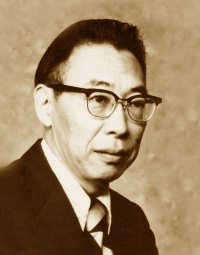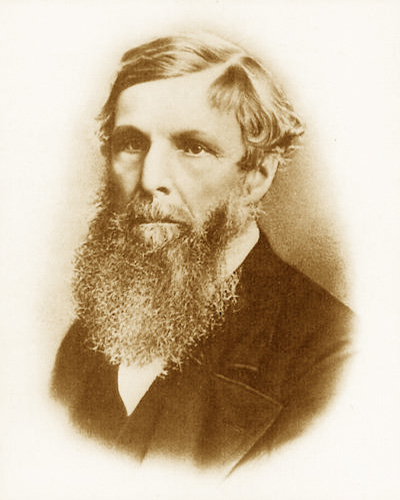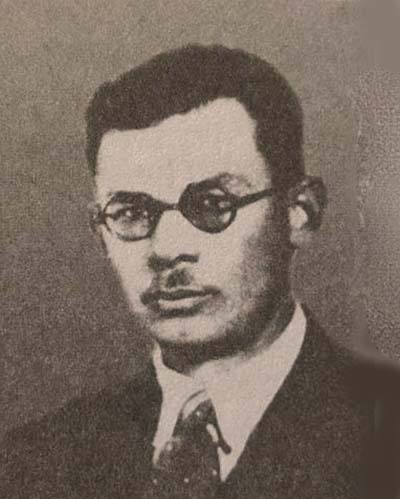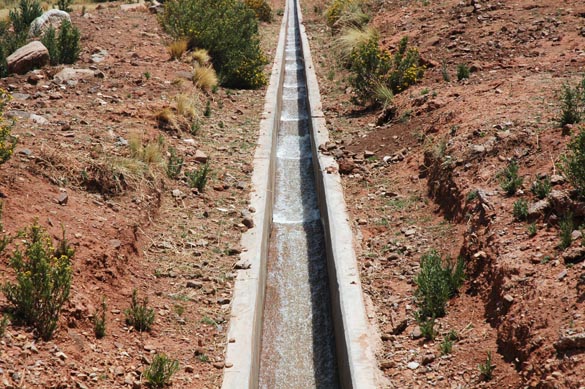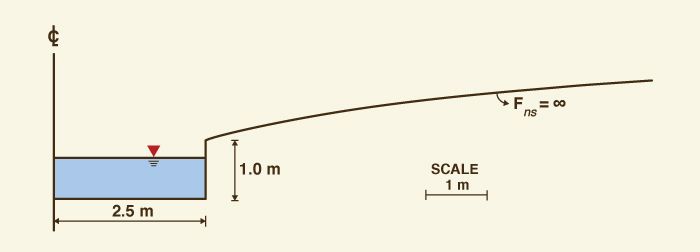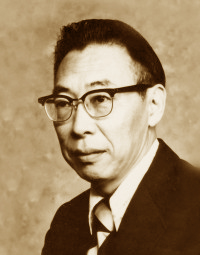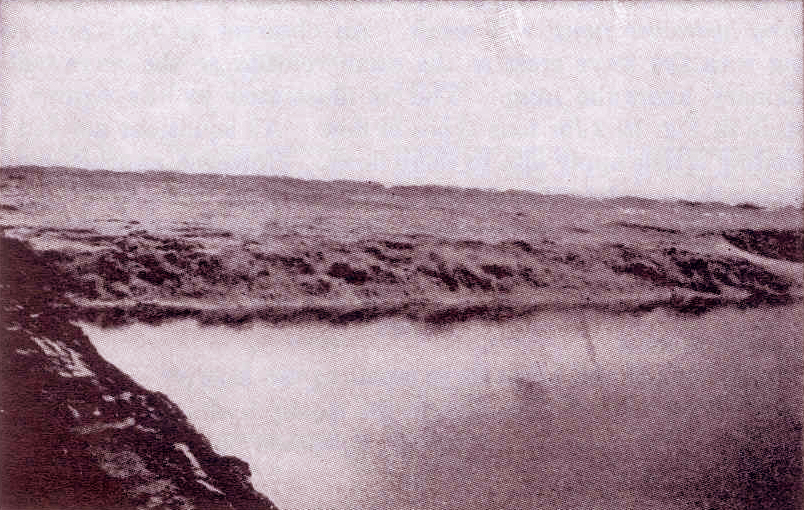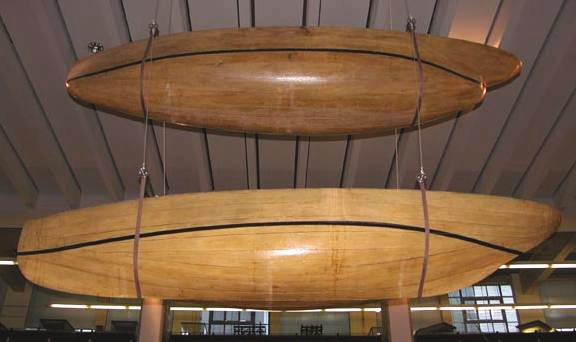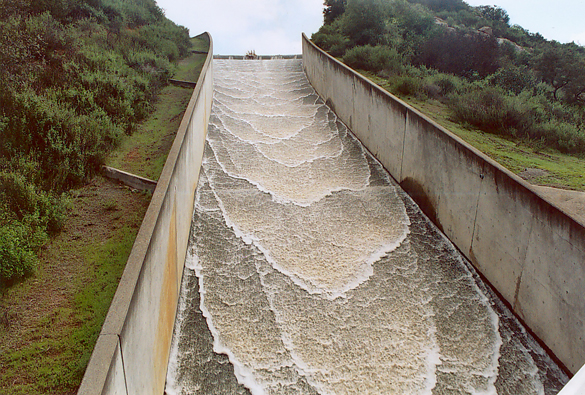There are three characteristic velocities in open-channel flow (Ponce 1991):
The Manning equation is (Chow 1959):
in which u = the mean velocity of the steady uniform flow, R = hydraulic radius, S = friction slope, and n = Manning friction coefficient. The Chezy equation is (Chow 1959):
in which C = Chezy friction coefficient. The Seddon formula expresses the kinematic wave celerity ck as follows (Seddon 1900; Chow 1959):
in which T = channel top width, Q = discharge, and y = flow depth.
The Seddon formula is alternatively expressed as (Ponce 1989):
in which β = exponent of the discharge-flow area rating:
The relative kinematic wave celerity v, or Seddon celerity relative to the flow, is:
The relative dynamic wave celerity w, or Lagrange celerity relative to the flow, is (Chow 1959):
in which g = gravitational acceleration, and y = flow depth.
The three velocities u, v, and w, expressed by Eqs. 1 or 2, and 6 and 7, respectively, give rise to two independent, dimensionless numbers, the Froude and Vedernikov numbers (Powell 1948; Ponce 1991). The third number, or third possible combination, is expressed in terms of the other two. The Froude number is the ratio of u and w :
The Vedernikov number is the ratio of v and w :
The third number is the ratio of v and u :
Note that the quantity
The Froude number describes the condition of (1) subcritical, (2) critical, or (3) supercritical flow (Chow 1959).
Under subcritical flow, dynamic waves can travel upstream because
The Vedernikov number describes the condition of (1) stable, (2) neutral, or (3) unstable flow (Chow 1959).
Under stable flow, kinematic waves travel slower than dynamic waves because
The parameter β characterizes the type of friction and cross-sectional shape; for instance,
Table 1 shows values of Fns for selected
values of β corresponding to typical combinations of types of friction and shape of cross section,
from a high of
Table 1 shows that the value
From Eq. 5, for
Ven Te Chow was born in Hangchow, China, on August 14, 1919 (Fig. 3).
He received his B.S. in civil engineering from the National Chiao Tung University in 1940,
his M.S. in engineering mechanics from Pennsylvania State University in 1948,
and his Ph.D. in hydraulic engineering from the University of Illinois in 1950 (Ackermann 1984).
He became a naturalized U.S. citizen in 1962, and was on the civil engineering
faculty at the University of Illinois from 1948 until his death in 1981.
Chow is the author of the following widely acclaimed books: (1)
Open-channel hydraulics, published in 1959, from which Fig. 4 was extracted; (2)
Handbook of Applied Hydrology, published in 1964; and (3) Applied Hydrology, with coauthors David Maidment
and Larry Mays, published in 1989.
The Froude number is attributed to William Froude, who was born in Dartington, Devon, England in 1810, and died from a stroke
on a cruise to South Africa in 1879, at age 69 (Fig. 5).
In 1861, Froude wrote a paper on the design of ship stability in a
seaway..
Later, between 1863 and 1867, working with physical models of ships,
he showed that the frictional resistance
in the model (at reduced scale) and prototype (the actual ship) were equal when the speed V was proportional to
the length L, of the ship, to the power 1/2:
in which k is a constant that applies to both model and prototype.
Froude called this physical law the "Law of Comparison." He was the first to identify the most efficient shape for the hull of ships,
as well as to predict ship stability based on studies using reduced-scale models (Fig. 6).
In open-channel hydraulics, Froude's Law is embodied in the Froude number,
defined as follows (Chow 1959; Brater and King 1976):
in which D
is the hydraulic depth, defined as the flow area divided by the top width.
Note that for application to open-channel flow,
the horizontal length L in Froude's Law (Eq. 12)
has been replaced by the hydraulic depth D (Eq. 13).
This equation is basically the same as Eq. 8, wherein the hydraulic depth D has been approximated as the
flow depth y.
The calculation of the Froude number can be performed online using ONLINE FROUDE.
5. THE VEDERNIKOV NUMBER
The concept of Vedernikov number was first published in a Soviet journal (Vedernikov 1945;
1946) (Fig. 7).
Craya wrote about the same concept in a paper published in 1952 (Craya 1952).
Note the unfortunate confusion in Craya's seminal paper, where the Lagrange [dynamic wave] celerity
is described as governed by gravity [sic] and inertia.
The role of the several forces acting in unsteady flow in open channels (gravity, friction, pressure gradient, and inertia)
has been clarified by Ponce and Simons (1977), who
calculated the dimensionless relative wave celerity throughout
the dimensionless wavenumber spectrum. Under Chezy friction, for Froude number F = 2, that is,
To reiterate, the Vedernikov-Craya criterion states that roll waves will form in an open channel
under the following condition, in terms of absolute celerities:
In terms of relative celerities, roll waves will form when the relative Seddon celerity is greater than or equal to the relative Lagrange celerity:
Figure 8 shows roll waves forming on the spillway of Turner reservoir, in San Diego County, California,
following spillage after heavy rains, on February 24. 2005. Note that the no-slip condition on the vertical walls
makes the waves appear as if the flow were three-dimensional.
The calculation of the Vedernikov number can be performed online using
ONLINE VEDERNIKOV.
6. THE VEDERNIKOV NUMBER IN CHOW'S
OPEN-CHANNEL HYDRAULICS
In Section 8-8, Instability of Uniform Flow, of Open-channel hydraulics,
Ven Te Chow describes a criterion "which may be called the Vedernikov number" as follows:
in which x = exponent of hydraulic radius R in the general velocity formula
in which b = exponent of Reynolds number R
in the frictional power law
The parameter γ is a cross-sectional shape factor defined as follows:
in which R = hydraulic radius; P = wetted perimeter; and A = flow area.
The shape factor γ varies in the range 0-1. The value
The derivative is: dP/dA = d1 (P/A) = d1/R.
In Eq. 18, for
With Eq. 8, Eq. 16 reduces to (Chow 1959):
which implies that the Vedernikov number is a function of the Froude number, a statement
which is strictly not correct. The examination of Eqs. 8 to 10 reveals that
the Froude and Vedernikov numbers are totally independent of each other.
The confusion arises only circumstantially because the relative kinematic
wave celerity v is expressed in terms of the mean velocity u (Eq. 6).
Given Eq. 10, it follows that:
which states that β contains information on both friction (x)
and cross-sectional shape (γ).
Table 2 summarizes
the relations between b, x, γ, d1 and β for a wide range of flow conditions.
[In Eq. 17] [Eq. 17] [Eq. 18] [In Eq. 19] [Eq. 21] [In Eq. 4]
The question remains as to why Chow placed the Vedernikov number in Chapter 8 of his book, as the
last section [Section 8-8] of the chapter entitled "Theoretical Concepts..." instead of placing it in Chapter 1,
together with the Froude number and other fundamental concepts.
This fact may have contributed to the relative obscurity of the Vedernikov number, which persists to this date despite the passing of more than half a century.
Many practicing engineers, while they acknowledge having consulted the book many times, have yet to discover the Vedernikov number
(Ponce 2003).
7. CONCLUDING REMARKS
The concepts of Froude and Vedernikov numbers are reviewed on the occasion of the 50th anniversary of the publication of Ven Te Chow's Handbook of Applied Hydrology.
While the Froude number (F) is standard fare in hydraulic engineering practice, the Vedernikov number (V) remains to be recognized by many practicing engineers.
It is surmised here that this may be due in part to the fact that Chow placed the Vedernikov number in Chapter 8 of his book,
instead of placing it in Chapter 1,
together with the Froude number.
A comprehensive description of the variation of β, the altogether important
exponent of the discharge-flow area rating
ACKNOWLEDGEMENT
The writer wishes to thank Aleksandr Gostomelsky, a 2014
graduate of the
M.S. program in civil engineering at San Diego State University,
who searched for
and eventually found the photograph of Prof. V. V. Vedernikov that we have
posted on the top of this article, along with those of Ven Te Chow and
William Froude.
REFERENCES
Ackermann, W. C. 1984. Ven Te Chow, 1919-1981.
Memorial Tributes: National Academy of Engineering, Vol. 2.
Brater, E. F., and H. W. King. 1976.
Handbook of Hydraulics. 6th Edition, McGraw-Hill, New York.
Chow, V. T. 1959.
Open-channel hydraulics. McGraw-Hill, New York.
Craya, A. 1952. The criterion for the possibility of roll-wave formation. Gravity Waves,
Circular 521, National Bureau of Standards, Washington, D.C., pages 141-151.
Liggett, J. A. 1975.
Stability. Chapter 6 in
Unsteady flow in open channels, Vol. 1, K. Mahmood and V. Yevjevich, editors, Water Resources Publications, pages 259-281.
Lighthill, M. J., and G. B. Whitham. 1955.
On kinematic waves: I. Flood movement in long rivers.
Proceedings of the Royal Society, Vol. 29, A, No. HY12, pages 281-316.
Ponce, V. M., and D. B. Simons. 1977.
Shallow wave propagation in open channel flow.
Journal of Hydraulic Engineering, ASCE, Vol. 103, No. HY12, pages 1461-1476, December.
Ponce, V. M. 1989.
Engineering Hydrology: Principles and Practices. Prentice Hall, Englewood Cliffs, New Jersey.
Ponce, V. M. 1991. New perspective on the Vedernikov number. Water Resources Research, Vol. 27, No. 7, pages 1777-1779, July.
Ponce, V. M. 1992.
Kinematic wave modelling: Where do we go from here?
International Symposium on Hydrology of Mountainous Areas, Shimla, India,
May 28-30, pages 485-495.
Ponce, V. M., and P. J. Porras. 1993. Effect of cross-sectional shape on free-surface instability.
Journal of Hydraulic Engineering, ASCE, Vol. 121, No. 4. pages 376-380, April.
Ponce, V. M. 2003.
That's the one we skip! Legacy Tales, link 970 in ponce.sdsu.edu.
Powell, R. W. 1948.
Vedernikov's criterion for ultra-rapid flow.
Transactions, American Geophysical Union, Vol. 29, No. 6, 882-886.
Seddon, J. A. 1900.
River hydraulics. Transactions, ASCE, Vol. XLIII, pages 179-243, June.
Vedernikov, V. V. 1945. Conditions at the front
of a translation wave disturbing a steady motion of a real fluid.
Comptes Rendus (Doklady) de l' Académie des Sciences de l' U.R.S.S., Vol. 48, No. 4. pages 239-242.
Vedernikov, V. V. 1946. Characteristic features of a liquid flow in an open channel.
Comptes Rendus (Doklady) de l' Académie des Sciences de l' U.R.S.S., Vol. 52, No. 3, pages 207-210.
1 This paper was presented at the
ASCE EWRI World Environment and Water Resources Congress, held June 1-5, 2014. in Portland, Oregon.
The Chow Commemorative Sessions, three in total,
were organized
by Dr. Arie Ben Zvi, a former student of Prof. Ven Te Chow, to recognize Chow's contributions to the hydraulic and hydrologic engineering profession, on the
50th Anniversary of the publication of his seminal work, Handbook of Applied Hydrology.
| |||||||||||||||||||||||||||||||||||||||||||||||||||||||||||||||||||||||||||||||||||||||||||||||||||||||||||||||||||||||||||||||||||||||||||||||||||||||||||||||||||||||||||||||||||||||||||||||||||||||||||||||||||||||||||||||||||||||||||||||||||||||||||||
| 220224 |
